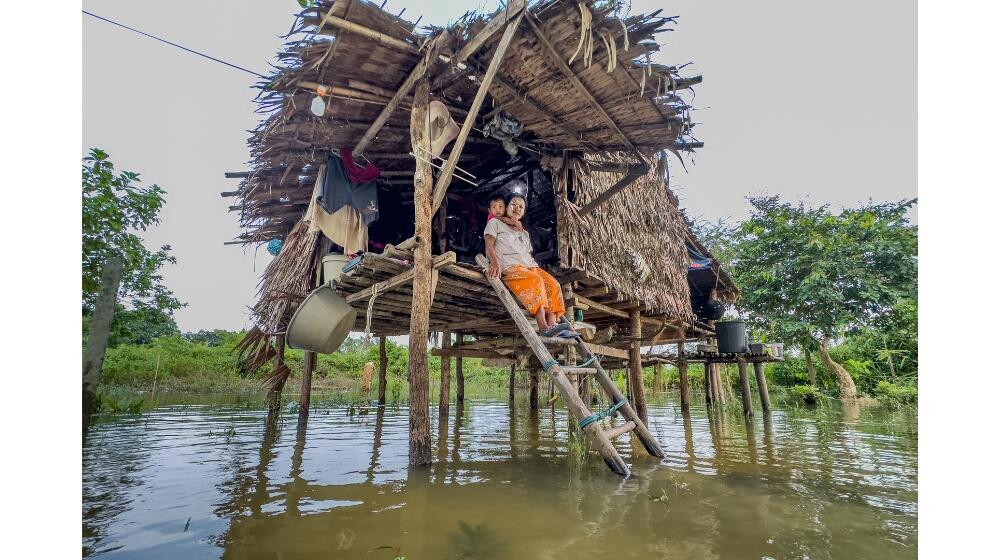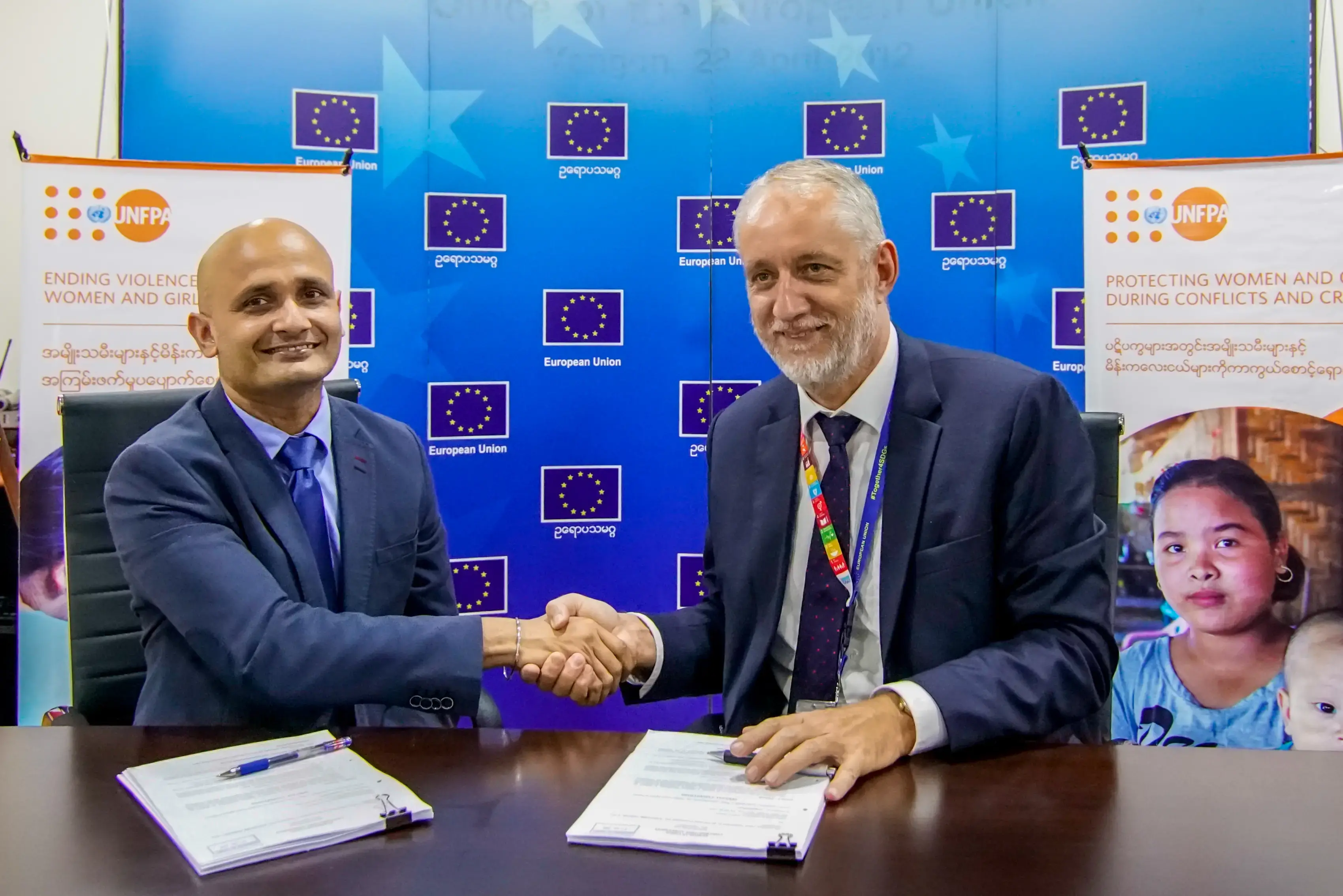"The water rushed into my house. In just a few minutes, everything I owned was gone—my home, my small farm, livestock, and everything I belonged to. I can’t even imagine how we will recover from this," says Nang, a pregnant woman, her voice trembling with grief. Displaced by the floods that have swept through her village in Shan State, Nang, like so many other women, now faces an uncertain future in a crowded shelter.
Her story is one of thousands emerging from Myanmar as the country battles one of its worst flood disasters in recent history. Torrential monsoon rains, exacerbated by Typhoon Yagi, have unleashed widespread devastation across Myanmar, affecting 1 million people across 70 townships. The floods, which began in early September, have submerged homes, destroyed farmlands, and forced entire communities to flee to temporary shelters.
As the floodwaters continue to rise, the most vulnerable—women and children—are suffering the greatest impacts. Many, like Nang, have lost their homes and livelihoods. The flood has affected nearly half of Myanmar’s 14 states and regions, including Kayin, Mandalay, Rakhine, and Shan.

Throughout the country, the scale of the disaster is overwhelming. Entire communities have been engulfed by floodwaters, destroying crops, livestock, and homes. Although humanitarian efforts are underway, they are encountering significant challenges. Damaged infrastructure, blocked roads, and ongoing conflict in certain states and regions have made it difficult to access many of those in need. The hardest-hit regions, including Mandalay, eastern Bago, Kayin, Mon, and southern Shan, are in urgent need of emergency aid as communities struggle with the loss of their homes and livelihoods.
As the rainfall persists and river levels increase, the risk of more flooding remains high, and the difficulties of providing aid to affected areas are growing. The country is facing dual crises of conflict and flooding, leaving many women with nowhere to turn. According to the report by UNOCHA as of 27th September 2024, 600,000 women were affected by the flood nationwide, with 270,000 of them being of reproductive age and 13,000 pregnant.
Thida, who is eight months pregnant, is living in a crowded shelter after her home was destroyed by the flood. She described the overwhelming fear that grips her daily. "I was already worried about my pregnancy because of the conflict," she says. "Now, with the flood, it feels like everything is against us." Road blockages and damaged infrastructure have made it nearly impossible for her to access healthcare, leaving her uncertain about her baby’s safety.

UNFPA partners' mobile clinics play a crucial role in this challenging environment. These clinics offer vital sexual and reproductive health (SRH) services, including maternal health care and family planning (contraceptive) services to the affected population. Despite the logistical challenges posed by the floodwaters, these mobile units are reaching women in remote areas and shelters, providing life-saving care. For many women, these clinics are their only access to healthcare, as local health facilities have been affected by floods or are still inaccessible.
Moe Moe, an eight-month-pregnant woman from Kayin State, shared how the mobile clinic made a crucial difference for her. “I experienced flooding three times in the recent months of 2024. I was so worried for my baby in this difficult situation. I hadn’t been able to see a doctor since the flooding started. When the mobile clinic came to the place near where we live, I was so happy. They checked my baby’s health and gave me the vitamins and a clean delivery kit. I finally feel like I can breathe again, knowing I have the support and care I need for me and my baby,” she said with relief.

UNFPA’s clean delivery kits have provided critical support for pregnant women like Moe Moe, who are unable to get to a health facility during a crisis or emergency situation, preventing deadly infections and ensuring safe deliveries. "I was terrified that I wouldn't have access to a safe delivery. The mobile clinic brought me a clean delivery kit, and it gave me hope that, even in this situation, I can give birth safely," she says. The kits contain sterile supplies for childbirth, including a plastic sheet, a sterile towel, sterile gloves, an apron, soap, a sterile blade, an umbilical cord tie, and an information sheet for safe delivery.

In addition, Dignity kits containing essential hygiene products like sanitary pads, soap, and undergarments are another crucial intervention for humanitarian-affected women and girls. For Thandar, a 30-year-old woman, these kits have made an enormous difference. “Unlike men, women could not stay at the displacement shelter without proper clothing and protection. Having these hygiene products helps us feel a little more in control and confident,” she says. Yet, despite the relief these UNFPA’s dignity kits provide, the overwhelming need for safe, gender-segregated sanitation facilities in the shelters remains unmet.

Many women, displaced by the floods and living in temporary shelters, are also struggling to access contraceptives. Nway Nway, a mother of three children, expressed her concerns. “After the repeated floodings in Kayin during this rainy season, I couldn’t get my contraceptives, and I’m not ready to have another child. I went to the mobile clinic, and they were able to provide me with what I needed. Without that, I don’t know what I would have done,” she explained.
The mobile clinics are providing not just maternal health services but also essential contraceptive services to women who would otherwise be left vulnerable to unplanned pregnancies or unwanted pregnancies in already dire conditions. With healthcare centres damaged and transportation routes cut off, these services are critical for women to regain control over their reproductive health.

In the displacement camps and temporary shelters, women are facing more than just the loss of their homes and livelihoods. Many have become targets of violence, as the displacement caused by the floods has made them even more vulnerable. The lack of privacy, overcrowded living conditions, and insufficient security in the camps have led to an increase in Gender-Based Violence (GBV).
GBV prevention and response have become increasingly challenging in the ongoing conflict, where access to affected areas is restricted, and GBV support services are limited. A local GBV organization supported by UNFPA shared the challenges they face: “In the midst of floodings, we are trying every option and using every available resource to continue supporting displaced women affected by GBV at their home or temporary displacement shelter. The political situation makes it even more difficult, but we know we need to help and protect each other in these challenging times with the limited support available.”

At the heart of the response are community volunteers like Htar, whose dedication has been instrumental in supporting affected women and girls during the floods. Volunteers have been working tirelessly alongside UNFPA and other partners to distribute relief items such as dignity kits and raise awareness about available health services. They also serve as crucial links between the affected communities and healthcare service providers, ensuring that women in the most remote areas are reached.
Htar, a local youth volunteer from Kayin State, spoke passionately about the urgency of their work: “In a disaster like this, we know that time is everything. The sooner we reach the affected people, the better chance they have of staying healthy and safe. With the support of UNFPA, we’ve been able to distribute dignity kits and clean delivery kits in the affected areas within 72 hours. Some team members are providing relief support in affected areas, while others are trying to connect with local donors and service providers for immediate support, and some are collecting data on the affected to identify urgent locations in need. We know that our work is risky, and the conditions are tough, but seeing the smiles on people’s faces makes all the hardship and exhaustion fade away.”
As the floodwaters begin to recede, the challenges remain immense. Women and girls continue to bear the brunt of the crisis, facing heightened risks of GBV, poor access to reproductive healthcare, and disruption of their livelihoods and incomes. UNFPA’s support through partners on the ground, including mobile clinics, dignity kits, clean delivery kits, and family planning services, is critical to ensuring their health, safety, and dignity. However, the need for more funding and resources is urgent. According to UNOCHA, only 28% of the 2024 Humanitarian Needs and Response Plan has been funded, leaving large gaps in the response. This funding shortfall is even more acute in services aimed at GBV prevention and response, with only about 12% of the required funds received, which is less than half of that for the overall HNRP. This drastic underfunding severely limits the ability to provide adequate support to women and girls who are at an increased risk of gender-based violence in the chaotic conditions of displacement camps.

For women like Nang, Moe Moe, and Nway Nway, the flood has completely disrupted their lives in ways they never anticipated. However, with the ongoing support of community members, youth volunteers, local service providers, and humanitarian partners, there is hope that they can start to rebuild not only their homes but also their futures.
The story of Myanmar's flood crisis is full of challenges, but it also reflects resilience and hope. With continued support, the women of Myanmar can transition from merely surviving to thriving, guiding their communities toward a stronger, more resilient future.




